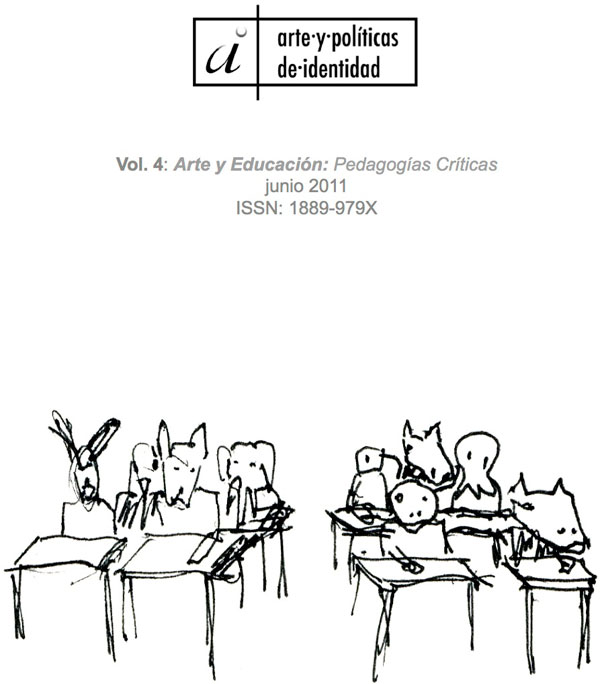Seeing the Whole: Art, Ecology and Transdisciplinarity
Abstract
Climate Change and species extinction are perhaps two symptoms of a psychotic society that has lost contact with reality. The pandemic pathology of economic and industrial values have possibly altered the very course of planetary evolution. As humankind starts to recognize that apocalyptic change is imminent, the practice of art(s) may be an essential discipline to emerge beyond collapse.
This paper considers art in an ecological context to help us ‘see anew’ the potential for adopting complex ways of thinking, and ‘transdisciplinary’ ways of working. Challenging existing belief systems and normative ways of thinking through ‘question-based learning’, we may consider drawing as a means of gaining insights and practical approaches to diverse futures. ‘Turning the face of disaster to the face of opportunity’, this paradigm shift attempts ‘to bring the whole to life’ through ‘growth ecology’.
Downloads
-
Abstract381
-
PDF (Español (España))256
References
Alexander, C., Neis, H., Anninou, A., King, I. (1987). A New Theory of Urban Design. New York: Oxford University Press.
Bateson, G. (2000). Steps to an Ecology of Mind. Chicago: University of Chicago Press.
Capra, F. (1996). The Web of Life: A New Synthesis of Mind and Matter. London: HarperCollins.
---------(1999). Eco Literacy: The Challenge for Education in the Next Century. Liverpool Schumacher lectures 20 March 1999. California: Centre for Ecoliteracy, Berkley.
De Certeau, M. (1985). Pay Attention: To Make Art. In M. H. Harrison, & N. Harrison, The Lagoon Cycle, exhibition catalogue. New York: Ithaca.
Dieleman, H. (2010). Aritsitc Rationality in Sustainability Projects: theory and practice. Summer School of Arts and Sciences for Sustainability in Social Transformation. Retrieved in 2011 from http://assist2010.ning.com/profiles/blogs/hans-dieleman-artistic
Gablik, S. (1992). The Reenchantment of Art. New York: Thames and Hudson.
Haley, D. (2000). Seeking an Unacceptable Profile: species nova [to look anew] #1. Performed arts/research installation, commissioned for Between Nature international symposium at Lancaster University.
---------(2001). Reflections on the Future – “O brave new world”: a change in the weather. In A.Remesar (ed.), Waterfronts of Art I, Art for Social Change (pp. 97-112). Barcelona:University of Barcelona, CER POLIS, Spain. Retrieved in March, 2011, from www.ub.es/escult/1.htm
Haley, D. (2008). The Limits of Sustainability: The Art of Ecology. In S.Kagan and V. Kirchberg, (Eds.), Sustainability: a new frontier for the arts and cultures. Frankfurt, Germany: VAS-Verlag.
---------(2011). In S. Kagan, and K. Verstraete (Eds.), Sustainable Creative Cities: the role of the arts in globalised urban contexts, ASEF (Asia-Europe Foundation) (pp. 34-38, 44). Retrieved in 2011 fromhttp://www.leuphana.de/fileadmin/user_upload/Forschungseinrichtungen/ikkk/kultursoziologie/files/ASEF_workshop_sustainable_creative_cities_long_report.pdf
---------(2011). Art & Grace. In W. Heim (Ed.), New metaphors for sustainability: metaphors for the continuation of life. The Ashden Directory. Retrieved in 2011 from http://www.ashdendirectory.org.uk/featuresView.asp?pageIdentifier=2011414_37524050http://ashdenizen.blogspot.com/2011/07/new-metaphors-for-sustainability-art.html
Harrison, H. M. & Harrison, N. (2008). Public Culture and Sustainable Practices: Peninsula Europe from an ecodiversity perspective, posing questions to Complexity Scientists. Structure and Dynamics: eJournal of Anthropological and Related Sciences, Volume 2, Issue 3, 2008,Article 3. Retrieved from http://repositories.cdlib.org/imbs/socdyn/sdeas/vol2/iss3/art3
Hockney, D. (1984). The South Bank Show, London Weekend Television House of Commons Audit Committee. (2007) The UN Millennium Ecosystems Assessment: First Report of Session 2006-07. London: The Stationery Office Limited.
Klee, P. (1989). The Pedagogical Sketchbook. London: Faber and Faber.
Lakoff, G & Johnson, M. (1980). Metaphors We Live. Chicago: University of Chicago Press.
---------(1999). Philosophy in the Flesh: The Embodied Mind and Its Challenge to Western Thought. New York: Basic Books.
Morin, E. (2005). Restricted Complexity, General Complexity. In Philpapers org. Retrieved from http://philpapers.org/rec/MORRCG
---------(2008). On Complexity. New Jersey: Hampton Press Inc.
Nicolescu, B. (2008). Transdisciplinarity: Theory and Practice. New Jersey: Hampton Press Inc.
Works published in this journal are subject to the following terms:
- The Service of Publications from the University of Murcia (publishing house) keeps the published works’ copyrights, and favors and allows the reuse of these works under the license indicated in point 2.
- Works are published in the journal’s online edition under the license Creative Commons Reconocimiento-NoComercial-SinObraDerivada 3.0 España(texto legal). They can be copied, used, disseminated, transmitted and publicly exhibited, as long as: i) the author and original source of publication are cited (journal, publishing house and work’s URL); ii) they are not used for commercial purposes; iii) the existence and specifications of this license are mentioned.
3. Conditions for auto-file. It is allowed and encouraged that authors share electronically their pre-print version (the pre-reviewed version) and /or post-print version (the reviewed and accepted version) of their Works before the publication, since it promotes its circulation and dissemination. RoMEO color: green.










